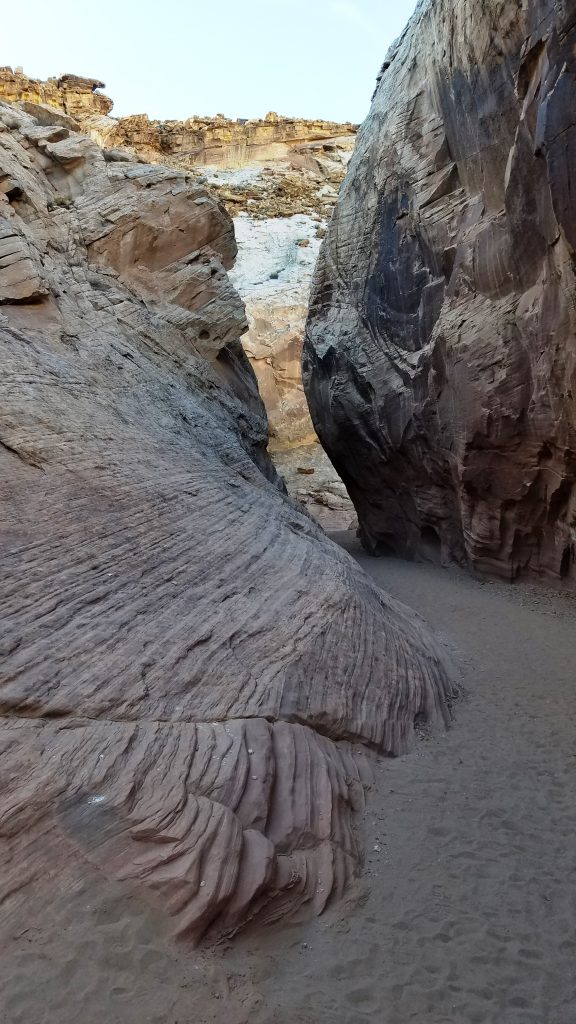
FEATURE — Many first-time Goblin Valley State Park visitors, upon seeing the state park’s vast array of red rock formations, say they feel like they are on another planet. Technically known as hoodoos, the formations resemble anything one’s imagination can think up.
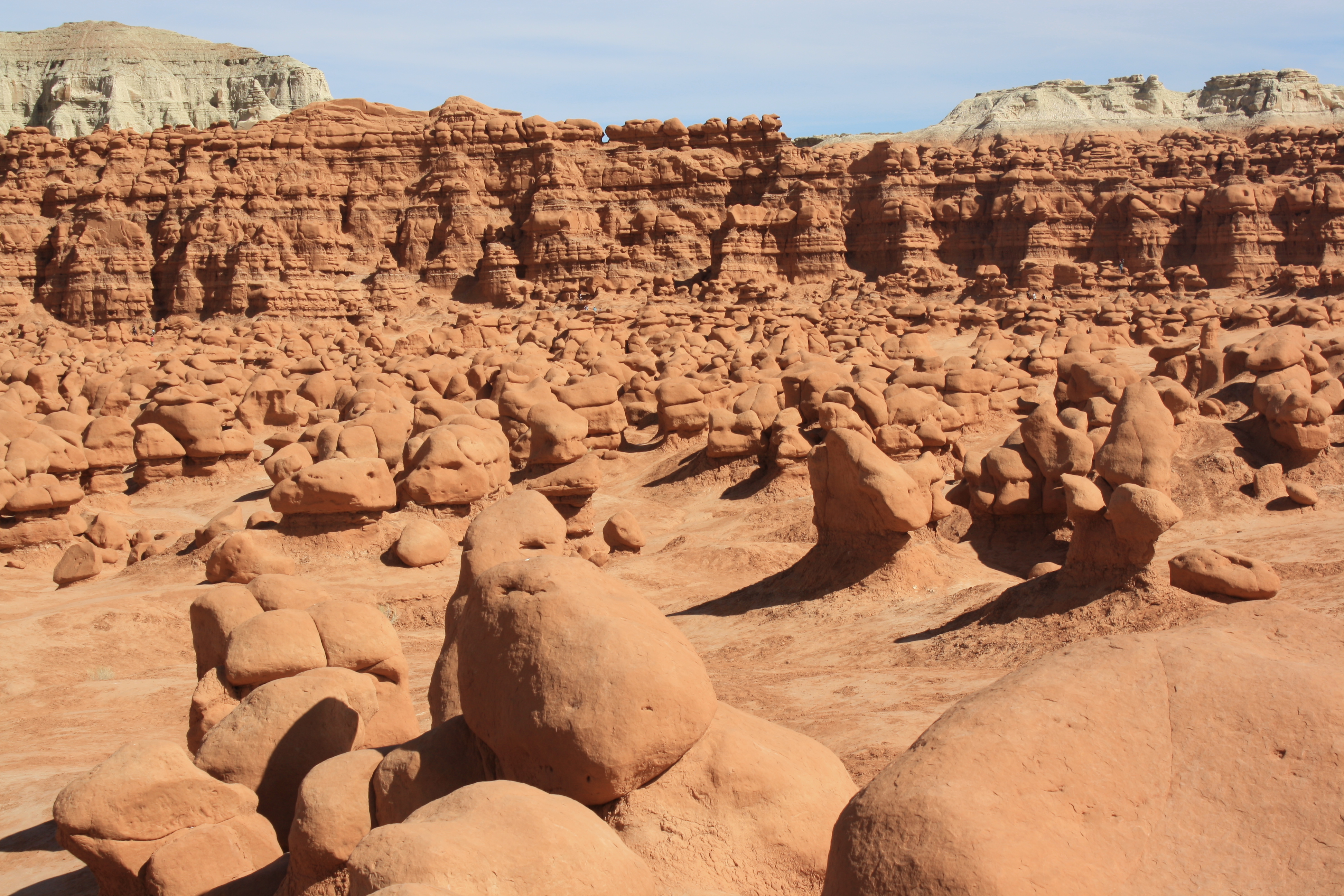
“Goblin Valley is filled with stone babies, goblins, ghosts and toadstools that range in height from 10 to 200 feet,” said longtime Salt Lake Tribune reporter and columnist Tom Wharton in the Utah guide he wrote as part of the “Compass Guides” series.
“They stand like families of red goblins poured out, one by one, by a giant wizard and left frozen in time.”
Other guests and writers have described it similarly, some comparing it to the surface of Mars.
While not actually off the surface of Earth, Goblin Valley has served as a stand-in for another planet in the 1999 “Star Trek” spoof “Galaxy Quest” and as inhospitable terrain in a few other movies.
But the scenic wonderland literally wasn’t on the map until 1949.
“Valley of the Mushrooms” – the 1949 expedition
When one thinks of famous explorers in Utah’s history, names such as Dominguez and Escalante, John C. Fremont, Parley P. Pratt and John Wesley Powell might come to mind but probably not Arthur Chaffin.
By 1949, one would think Utah would have already been completely explored and mapped, but that wasn’t the case. Goblin Valley still remained a mystery. However, when San Francisco resident Philip Tompkins – a land assayer, explorer and amateur historian – just couldn’t get enough of the incredible scenery of the Utah and Arizona deserts, he became the impetus for an exploring expedition into the now-iconic bastion of Utah scenery.
Tompkins made the acquaintance of Chaffin and hired him as his guide, saying he’d like to see some new scenery.

Chaffin first came across Goblin Valley on horseback in 1921 while, as Wayne County Commissioner, he was looking for a feasible route for an oiled road between Caineville and Green River. The area had likely been visited previously by Native Americans and cattle ranchers searching for straying steers, but the “discovery” of Goblin Valley is clearly pinned on him.
During that 1921 exploration, Chaffin took notice of the area and marked its location on a rough map that he put in his saddlebags, but he never forgot about the area, trying to no avail to interest his photographer friends to join him in a more thorough exploration.
Chaffin became a pioneer in the tourist trade in southeastern Utah, operating a ferry across the Colorado River at what is now Lake Powell’s Hite Marina all the while continually exploring the land.
After Tompkin’s request to see something a little different, Chaffin knew he’d found just the person to accompany him back to what he first christened “Valley of the Mushrooms.”
“Chaffin reached into his desk drawer, pulled out the map he’d scrawled many years before, and said ‘I think we might have something here to fit that bill,’” Barry Scholl wrote in a story about that 1949 expedition in the May/June 1997 issue of Salt Lake Magazine.
In September 1949, Chaffin and Tompkins set out with brothers Perry and Worthen Jackson to explore the showcase of red rock curiosities. They rattled over the open desert in a filled-to-the-brim war surplus Jeep with Chaffin alternately leading and riding his horse, Star. Within a mile of reaching their destination, the Jeep became stuck the the desert’s deep sand, prompting the men to abandon it and trudge on with Chaffin leading the way atop Star. They reached Goblin Valley’s western edge on Sept. 20.
Seeing it rendered them speechless.
“I thought it was pretty amazing, I’ll tell you,” Perry Jackson told Scholl in an interview for his story. “None of us except Arthur had seen anything like it before, and even he didn’t have anything to say.”
Tompkins wrote an article of his impressions of his first visit in a 1954 article for National Parks Bulletin.
“The expanse, covered with thousands of sandstone figures, was overwhelming in its effect,” Tompkins wrote, adding that it looked like “a huge corral filled with animals.”
“At close range the grotesque figures suggested the name Goblin Valley. That was the name we gave it.”
Using “goblin” to describe it is certainly more mysterious and enticing than “mushroom.”

Within hours after their arrival, Tompkins could tell he didn’t have enough film to truly do the landscape justice, so the next day Chaffin dug out the Jeep, drove to Green River and wired for more film.
The exploring party stayed nearly a week in Goblin Valley, camping at a site just west of today’s developed campground, riding borrowed horses while exploring and photographing the hoodoos.
“Their only complaint, according to Jackson, was the lack of water (they were forced to travel ten miles to the nearest well) and the almost-constant winds blowing sand into their food,” Scholl wrote.
The group broke camp on Sept. 26, and on Oct. 16, Arthur and his wife, Della, accompanied Tompkins to Salt Lake City, where they described what they had seen at an informal press conference they scheduled with the Deseret News and Salt Lake Tribune.
In early 1950, the Deseret News Magazine published the first descriptions of Goblin Valley, and soon after, stories appeared in other Utah newspapers. Some of those journalists – like dime novel writers of the Old West – wrote the articles without even seeing the landscape for themselves.
After Tompkins began hearing about adventurous tourists seeking out the beloved geologic masterpiece he had just explored, he organized a letter-writing campaign to Congress, the Department of the Interior and the state of Utah seeking some sort of protection for the scenic wonderland. His ultimate goal was to see the area achieve national park status.
While the National Park Service was not receptive to the idea, Utah state officials were, and in 1954, the state paid $5,600 for 2,240 acres in the valley, eventually designating it a state park in 1964. The state leased some adjoining lands from the BLM in 1984 to increase the park’s land area by another 1,000 acres.
Goblin Valley’s geology
Upon seeing the surreal spectacle of wondrous sandstone, the inevitable question for most visitors is “How did these get here?”
The answer to that question is in an explanation of the geologic forces that formed the little “sprites.”
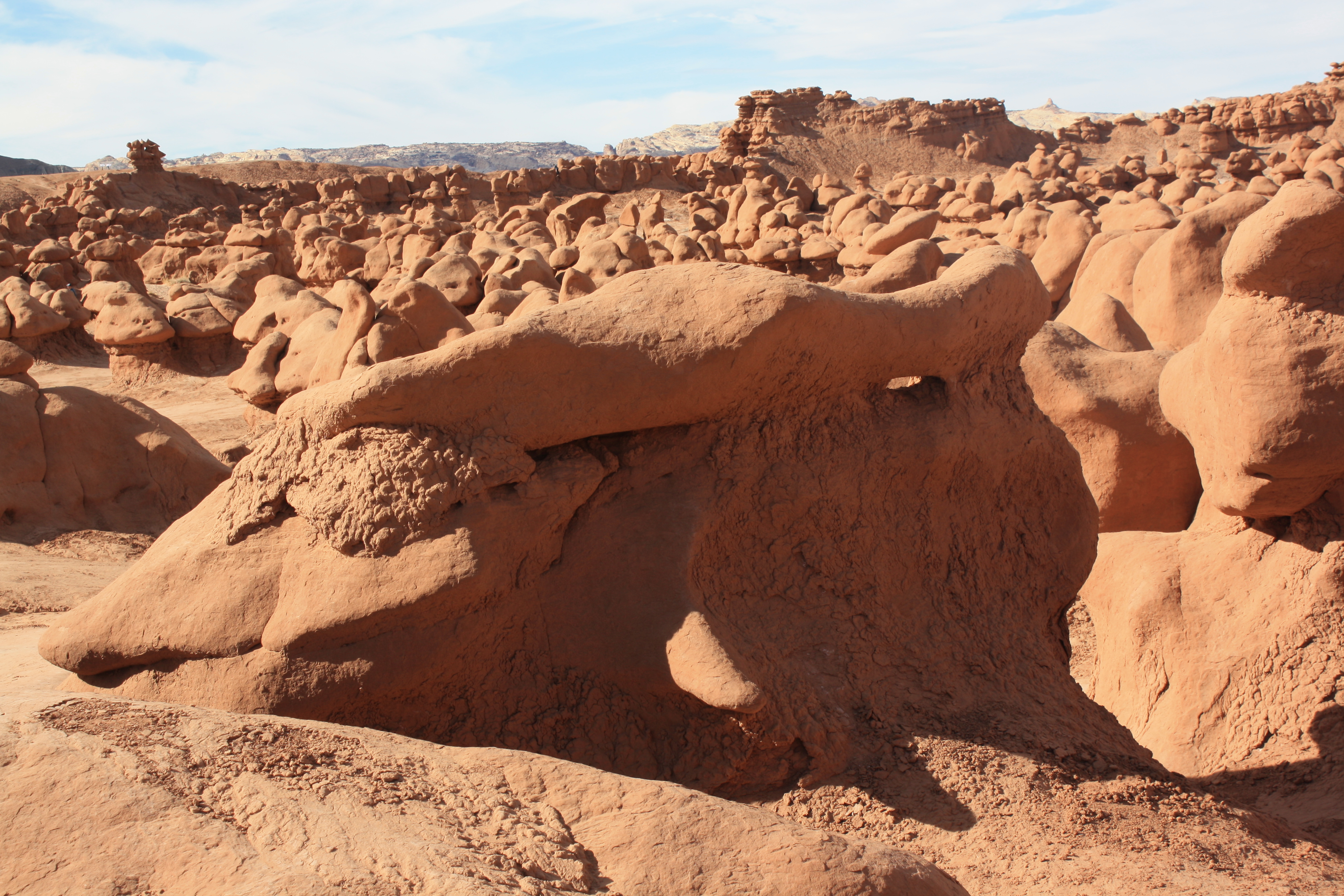
It seems unbelievable based on what Goblin Valley visitors see today, but the park’s varied goblin formations in their infancy were sediments left from an ancient sea approximately 145 to 170 million years ago. The deeply-buried layers of sand, silt and clay transformed into rock. Tremendous tectonic forces uplifted the area and prompted erosion that exposed those layers and began the process that fractured them, and water, wind and frost carved them over the eons of time into what they are now.
There are four geologic layers, or “formations” as they are known, in Goblin Valley. The oldest, lowest and most exposed layer is the Entrada sandstone, the layer where the hoodoos have formed and the same sandstone that forms the picturesque arches, fins and spires of Arches and Capitol Reef national parks. The layers above it include the Curtis formation, then the Summerville formation and the Morrison formation on top.
These formation form the layers of a geologic “cake,” which are easily present upon closer examination, especially on the cliffs behind the main valley of goblins that exposes softer, lighter-colored layers in between harder, darker-colored layers.
In Goblin Valley, the fractured Entrada sandstone formed zones of weakness with sharp edges and corners, which are susceptible to weathering more quickly in forming the spherical-shaped goblins. The interbedded and underlying shale and siltstone, which are less resistant to weathering than the sandstone beds that form the goblin bodies, help give the goblins their stacked appearance, elongated shapes and flat bottoms – essentially providing them a pedestal on a thin veneer of softer soil called colluvium.
Erosive forces continue to shape Goblin Valley today with older goblins toppling and weathering into oblivion. Fortunately, the process exposes new goblins.
Another planet? Goblin Valley as a film location
Probably the most famous movie that utilized Goblin Valley as a filming location was “Galaxy Quest,” the 1999 film about a set of washed-up actors who once starred in a science fiction TV show much like “Star Trek” who make their money by dressing up in their costumes and attending fan conventions. A troubled alien race sees reruns of their show, thinks they’re the real deal and enlists them to help save their planet, an adventure that takes them to the planet Epsilon Gorniar II (Goblin Valley).
Assistant Park Manager Nathan Martinez said filming the scenes from “Galaxy Quest” in the park were a big deal but thankfully low impact.
“Nothing was allowed to be wheeled down into the valley so it was all helicoptered into the valley and then setup,” Martinez said. “They used a lot of tennis balls to mark the CGI stuff and they also filmed some of it outside of the park on BLM property.”
The park still has one of the foam hoodoos that movie crews made for filming, Martinez said, but it is not on display and lies in one of the park’s sheds.
Another film that showcases the park’s other-wordly scenery is the 1991 cult classic “Rubin and Ed,” in which the lead character, Rubin (played by Crispin Glover, aka George McFly in “Back to the Future”), enlists the help of luckless salesman, Ed (played by Howard Hesseman), in a quest to bury Rubin’s dead cat, which is frozen in a cooler, in the Utah desert – Goblin Valley.
Parts of “City Slickers 2″ and most recently scenes of the 2011 coming-of-age drama “The Tree of Life” starring Brad Pitt and Sean Penn were also filmed in the park.
The “Goblin Topplers” – a cry to protect resources
Goblin Valley’s most recent notoriety came for a negative reason, unfortunately.
In October 2013, Boy Scout leaders Dave Hall and Glenn Taylor caused a sensation when they toppled one of the park’s formations claiming that it was a safety hazard.
After discovering a rock they thought looked loose and could fall at any moment, the duo decided that the rock posed a danger to hikers meandering along the trail below and took matters into their own hands.

Using brute force, Taylor dislodged the massive stone and let it tumble while Hall videotaped the occasion on his phone. After it fell, Glenn Taylor and his son, Dylan, cheered and gave each other high-fives.
“Some little kid was about ready to walk down here and die, and Glenn saved his life by getting the boulder out of the way,” Hall is heard saying in the video. “So it’s all about saving lives here in Goblin Valley.”
What ultimately got the duo in trouble was posting the video to YouTube, where to date it’s received over 5 million views.
After the incident, state officials said that Hall and Taylor could be charged with anything ranging from a misdemeanor to a second-degree felony.
Besides the criminal investigation, in the aftermath of the incident, the Boy Scouts of America barred the two gentlemen from its organization for life and they also received over 100 death threats.
In a later interview with the Salt Lake Tribune, Hall said he realized after the incident that “state and national parks are very, very sacred to a lot of people” and that he and his friend should not have decided the fate of the goblin themselves but should have consulted park management.
The state did prosecute them. They pled guilty to criminal mischief, were sentenced to probation and ordered to pay hefty fines.
The incident gave the park attention, but not in the way park managers desired.
“We received numerous phone calls from around the world,” Martinez said. “I think it was also a bit of a new precedent in that our county wasn’t exactly sure about how to prosecute it.”
One Utah lawmaker even proposed a bill specifically banning goblin toppling, but it never became law.
Read St. George News columnists’ counteropinions on the incident:
In the wake of the topplers episode, Goblin Valley’s visitation steadily increased, which prompted park management to make a renewed effort to help educate visitors on preserving the park’s resources by treading lightly.
In addition to keeping up with influx of visitors and educating them about protecting resources, one of the park’s main challenges is exacerbated by its remoteness – maintenance.
“It’s not like we can just run over to the hardware store to fix a facilities problem,” Martinez said. “We try to keep a lot of maintenance supplies on hand – and we have a fantastic region crew that provides a lot of support for big issues – but we are still working hard on keeping our solar and well systems up to date with the increased visitation.”
When asked about current visitation numbers in contrast to the park’s early days, Martinez said, “We are close to 200,000 visitors a year these days. So yes, I would say we are on the map now.”
Visiting Goblin Valley
Goblin Valley lies approximately 4 1/2 hours northeast of St. George in southern Emery County. The easiest route is to take Interstate 15 northbound until Interstate 70 (near Cove Fort), then head east on I-70 until Exit 149. From that exit, take state Route 24 south and follow the signs to the park.

While staying on the freeway is the fastest route, one can also reach Goblin Valley by utilizing state Route 20 (I-15 Exit 95) to U.S. 89 to SR 24 north, which meanders through various historic and scenic gems, including the Butch Cassidy Boyhood Home and Capitol Reef National Park.
Goblin Valley is like a giant playground for children, who will enjoy climbing on the goblins (most of which are not very high off the ground) of various shapes and sizes. Photo opportunities abound as each hoodoo is different from the last. The park features a visitor center, a large covered pavilion overlooking the main Valley of the Goblins, three established hiking trails and a campground.
Interpretive programs are available also, including ranger-guided moonlight hikes and night sky tours, which offer prime stargazing opportunities because of the park’s dark night sky.
Goblin Valley can be a springboard to visit other nearby scenic places such as Little Wildhorse Canyon and Bell Canyon, located in the San Rafael Swell and managed by the Bureau of Land Management.
The best times to visit are the spring and fall when the temperatures are milder.
For more information about Goblin Valley State Park, visit its website.
Click on a photo then use your left-right arrow keys to cycle through the gallery.

This historic photo shows Goblin Valley "discoverer" and explorer Arthur Chaffin, who is known for operating a ferry on the Colorado River at Hite, Utah, 1946 | Photo courtesy of Utah State Historical Society, St. George News

This historic photo shows a panorama of Goblin Valley taken by Philip Tompkins, who was the impetus for the 1949 expedition that explored what became Goblin Valley State Park, Utah, 1950 | Photo courtesy of Utah State Historical Society, St. George News

This historic photo taken by Al Morton shows a woman taking photos (bottom right) in Goblin Valley soon after the 1949 expedition, Goblin Valley State Park, Utah, circa 1950 | Photo courtesy of Utah State Historical Society, St. George News

These three large hoodoos greet Goblin Valley visitors near the park entrance, Goblin Valley State Park, Utah, March 2018 | Photo courtesy of Debbie Leavitt, St. George News

Panorama of Goblin Valley's hoodoos of varied sizes, Goblin Valley State Park, Utah, March 30, 2018 | Photo by Reuben Wadsworth, St. George News
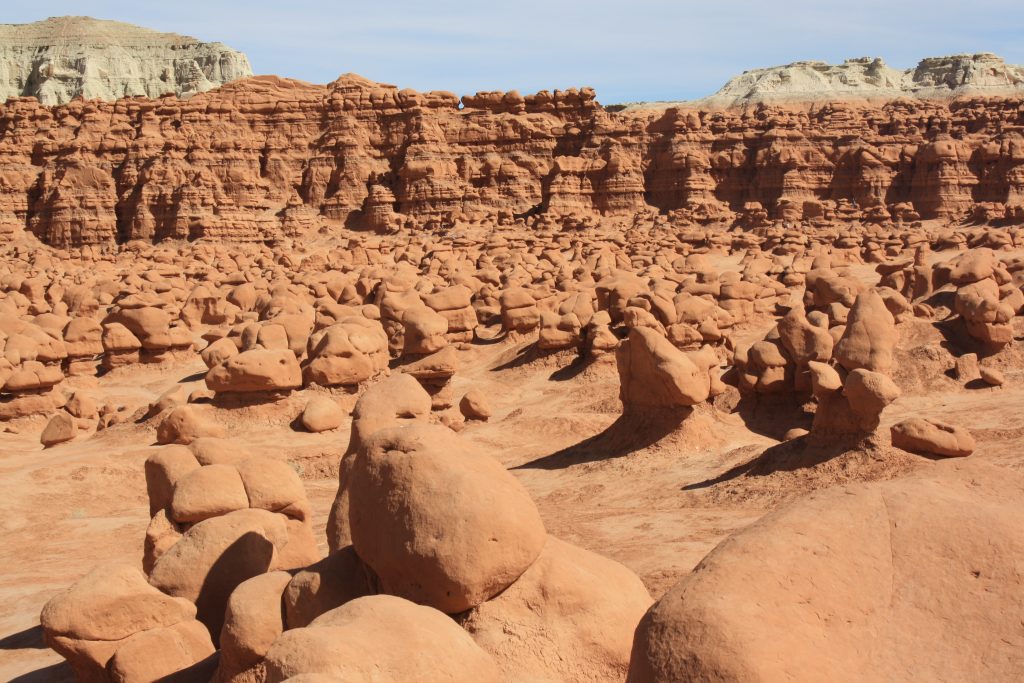
Panorama of Goblin Valley's hoodoos of varied sizes, Goblin Valley State Park, Utah, March 30, 2018 | Photo by Reuben Wadsworth, St. George News
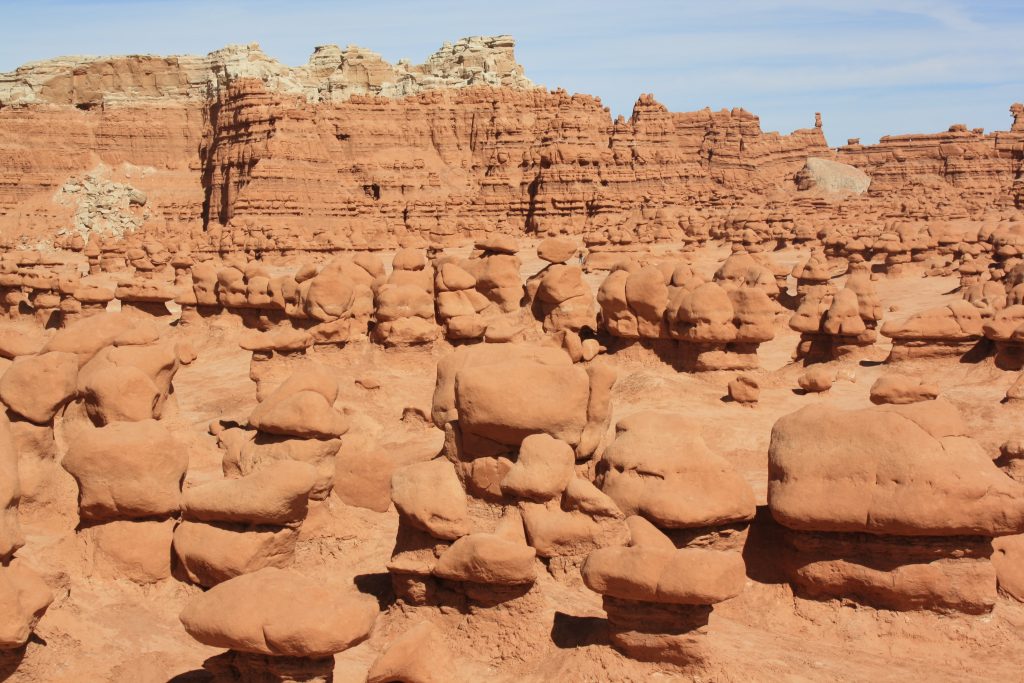
Panorama of Goblin Valley's hoodoos of varied sizes, Goblin Valley State Park, Utah, March 30, 2018 | Photo by Reuben Wadsworth, St. George News
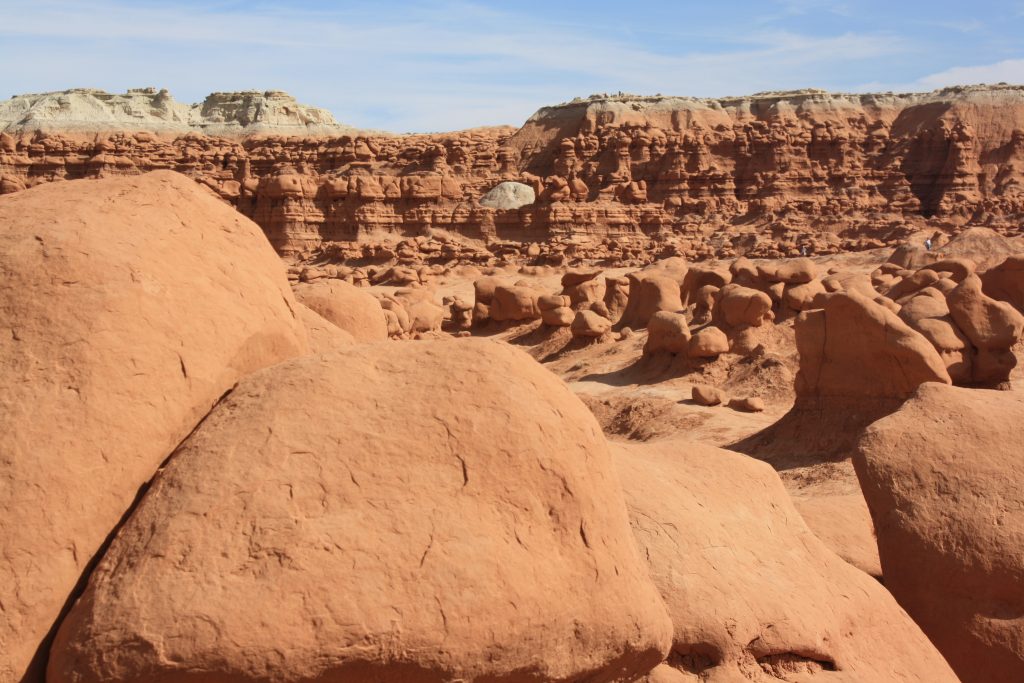
Panorama of Goblin Valley's hoodoos of varied sizes framed by large goblins in the foreground, Goblin Valley State Park, Utah, March 30, 2018 | Photo by Reuben Wadsworth, St. George News
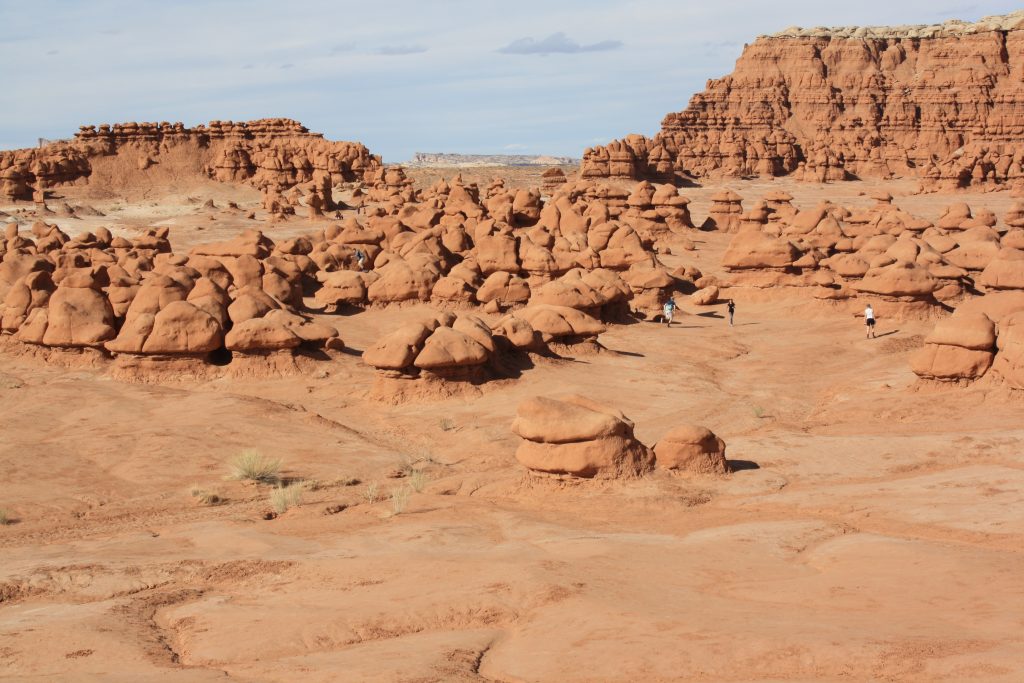
Hikers explore the hoodoos of Goblin Valley State Park, Utah, March 30, 2018 | Photo by Reuben Wadsworth, St. George News

Close up of goblin formations that resemble mushrooms, as Goblin Valley explorer Arthur Chaffin christened them when he first saw the valley in 1921, Goblin Valley State Park, Utah, March 30, 2018 | Photo by Reuben Wadsworth, St. George News
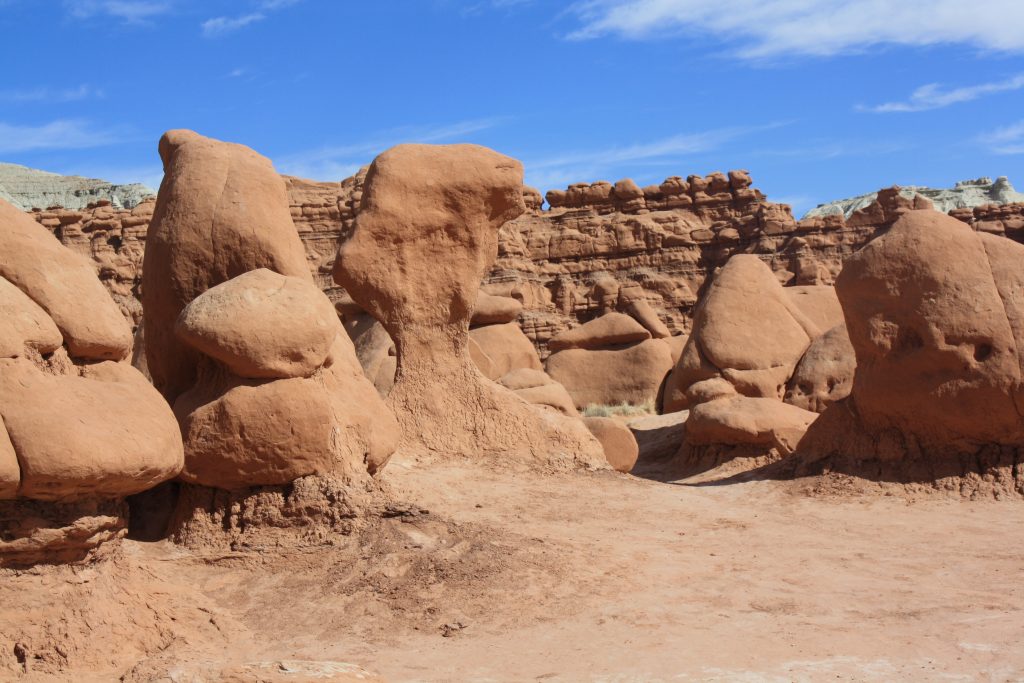
Close up of some of the formations in the Valley of the Goblins, Goblin Valley State Park, Utah, March 30, 2018 | Photo by Reuben Wadsworth, St. George News

A balanced rock among other goblins in Goblin Valley State Park, Utah, March 30, 2018 | Photo by Reuben Wadsworth, St. George News

Close up of some of the formations in the Valley of the Goblins, Goblin Valley State Park, Utah, March 30, 2018 | Photo by Reuben Wadsworth, St. George News
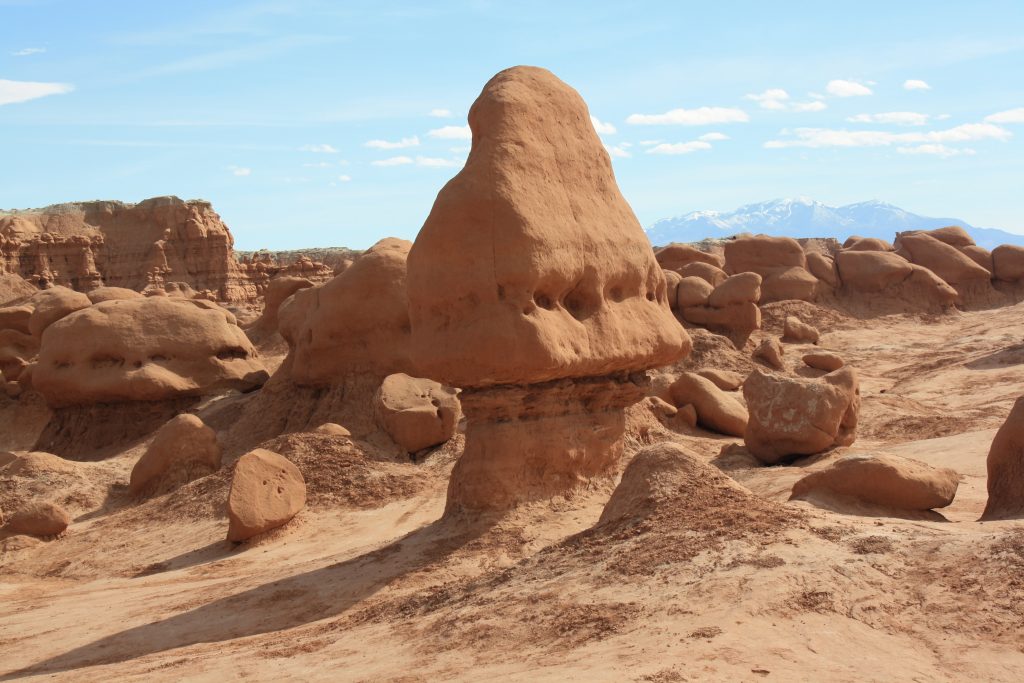
Goblins stand with the Henry Mountains in the background, Goblin Valley State Park, Utah, March 30, 2018 | Photo by Reuben Wadsworth, St. George News
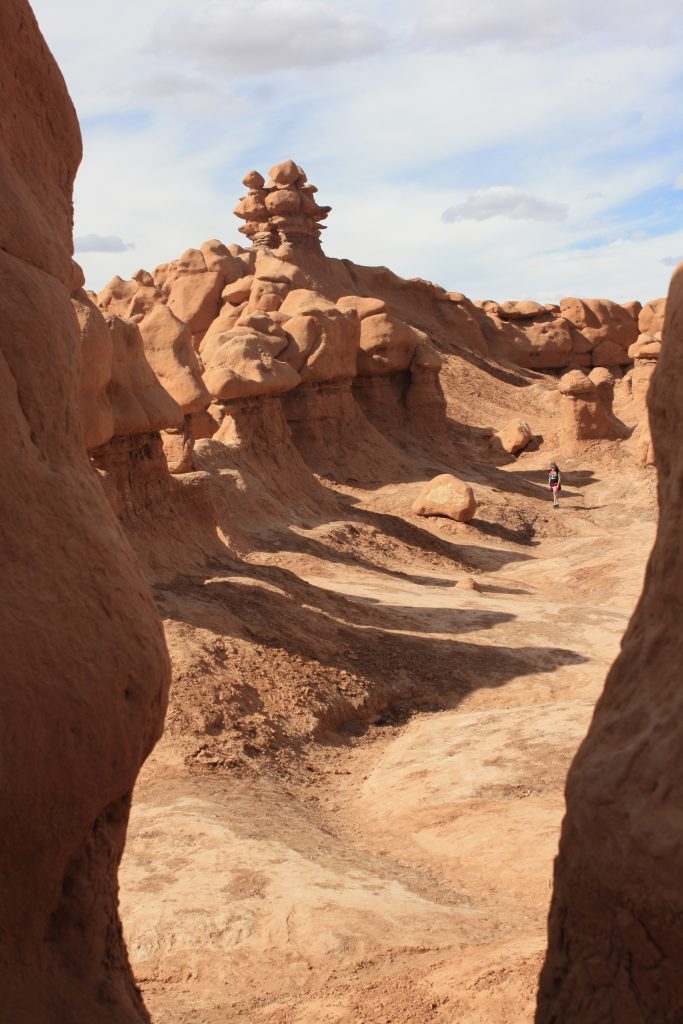
Two parallel goblins frame an otherworldly landscape enjoyed by a lone hiker, Goblin Valley State Park, Utah, March 30, 2018 | Photo by Reuben Wadsworth, St. George News
About the series “Days”
“Days” is a series of stories about people and places, industry and history in and surrounding the region of southwestern Utah.
“I write stories to help residents of southwestern Utah enjoy the region’s history as much as its scenery,” St. George News contributor Reuben Wadsworth said.
For previews on Days Series stories, insights on local history and information on upcoming historical presentations, please “like” Wadsworth’s author Facebook page.
Wadsworth has also released a book compilation of many of the historical features written about Washington County as well as a second volume containing stories about other places in Southern Utah, Northern Arizona and Southern Nevada.
Read more: See all of the features in the “Days” series.
Email: [email protected]
Twitter: @STGnews
Copyright St. George News, SaintGeorgeUtah.com LLC, 2022, all rights reserved.

